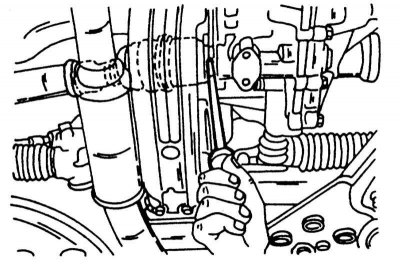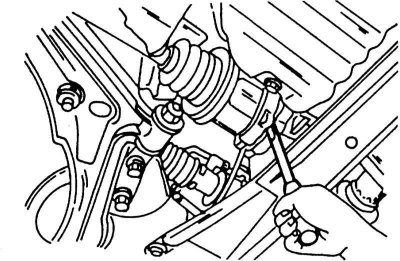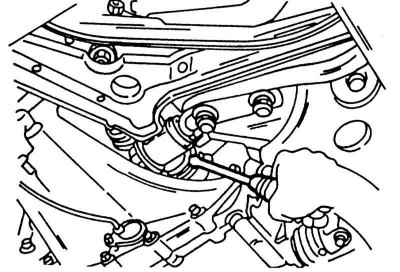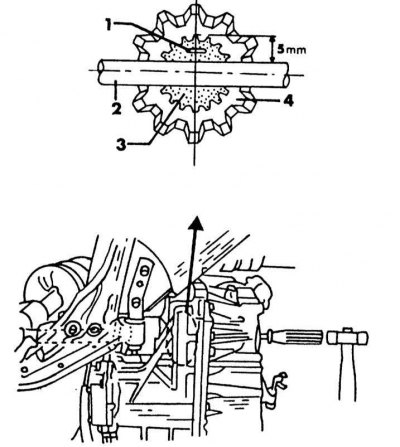Remove the circlip from the groove on the inner end of the drive shaft as it must always be replaced. If only the drive shaft needs to be removed, follow the instructions below:
1. Loosen the wheel nuts and knuckle nut while the wheel is on the ground and place the front of the vehicle on jack stands.
2. Unscrew the brake caliper from the steering knuckle and tie it with a piece of wire on the front suspension. Do not leave the caliper hanging on the brake hose. Do not depress the brake pedal again until the caliper is reinstalled.
3. Remove the tie rod ball joint nut and remove the joint with a suitable puller from the steering link arm (see Sections Steering without hydraulic booster and Power Steering (servo control)).
4. Separate the swivel on the upper side of the steering knuckle (see Section Front suspension), pull the steering knuckle out and knock the drive shaft out of the steering knuckle with a light metal hammer. To avoid damage to the threads of the drive shaft, screw the nut onto the shaft again until the outside is flush with the shaft. Be careful not to damage the rubber cuffs of the drive shafts. A thick rag can be wrapped around the rubber cuff. It may be that a puller is required to remove it.
5. Remove the drive shaft from the gearbox. If an automatic transmission is installed, the right shaft must be removed before the left shaft can be pressed out. When removing the shaft from the gearbox, proceed as follows:
- When removing the right shaft (illustration below) without a thrust bearing, insert a large screwdriver or pry bar in the manner shown in the illustration below into the gap between the hinge and the gearbox and squeeze out with a strong jerk of the screwdriver.

Install a screwdriver behind the CV joint to pry the CV joint away from the gearbox (right drive shaft).
- When removing the right thrust bearing shaft, place a screwdriver in the position shown in the illustration below and press out the shaft in the same way.

Removing the drive shaft from the gearbox with the thrust bearing installed (right shaft).
- When removing the left drive shaft with the manual transmission installed, use a large screwdriver. Insert it into the location shown in the illustration below and squeeze the screwdriver handle inward with a short jerk so that the shaft retaining ring pops out of the groove.

Removing the drive shaft from the gearbox with a manual gearbox installed (left shaft).
- When removing the left drive shaft with an automatic transmission installed, the job is a little more difficult, as the shaft must be knocked out from the other side of the transmission with a long screwdriver, which must have a blade that goes through so as not to damage the handle. Screwdriver installation is shown from above in the illustration below. The screwdriver must be installed in the position shown. Be careful not to damage the differential gear or gear shaft. Installation is carried out in the reverse order. Always replace the oil seal on the corresponding side of the gearbox. Nissan workshops use seal mandrels. Since in most cases amateurs do not have such mandrels at their disposal, you should be extremely careful when driving the stuffing box.
Removing the left drive shaft with the automatic transmission installed. Knock out the shaft with a screwdriver. Install a screwdriver 5 mm in front of the axis of the bevel gear:

1 - screwdriver; 2 - differential gear shaft; 3 - drive shaft; 4 - differential gear
6. Install a new snap ring on the end of the shaft and insert the shaft with splines into the differential gear. Firmly press the shaft until the circlip snaps into place in the gear groove. Then pull hard on the shaft to check if the circlip snaps into place. Perform all other work in reverse order. Once the wheels are on the ground again, tighten the drive shaft nut to 235 - 310 Nm, install the nut retainer and cotter the nut and shaft nut retainer. All other tightening torques are specified in Specifications at the beginning of the chapter.